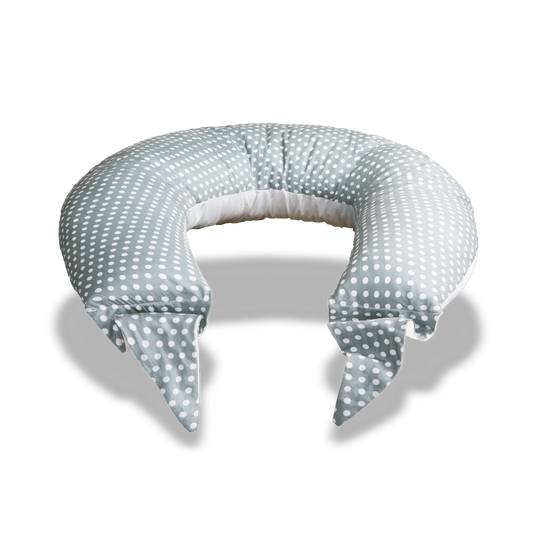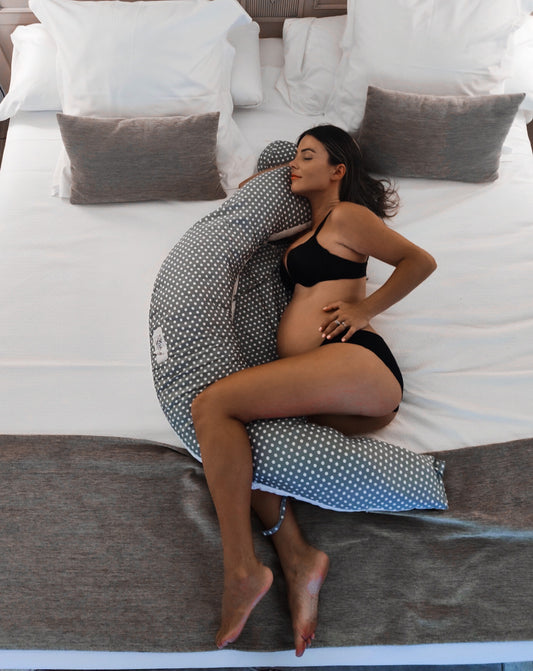It’s quite common to suffer from back pain after giving birth, this can be caused by the pregnancy itself in addition to the strain the actual birth has on the body.
Labour engages many different muscles. That’s why we feel tired and achy in the days following the birth.
Most women experience backache during pregnancy: this is because the uterus increases in size, organs move, and the curvature of the spine changes to maintain a balance in the centre of gravity.
These structural changes which occur inside the woman's body often lead to back pain. These pains can continue after childbirth as the spine returns to its original position.
What can help us to get back in shape – just as we were pre-birth? Let’s take a look together below.
What causes back pain after childbirth?
Muscle aches and pains are inevitable after childbirth, especially after a natural birth.
In addition to back pain, many women also suffer from headaches, pelvic floor dysfunction and shoulder, neck, and arm pain, caused by poor posture when holding and breastfeeding their baby.
Pain may vary in intensity depending on the birth, age, and body shape of each woman. It can often take more than a months for a new mum to regain her physical, and consequently, psychological equilibrium.
Pregnancy and childbirth cause considerable stress on the mum’s body and mind, including physiological and hormonal changes and various other issues.
Back pain is primarily due to the organs and the spine readjusting after the birth. In fact, as the woman’s bump grows, organs move, and the spinal column shifts its centre of gravity. Post birth, the reverse happens.
Secondly, back pain is linked to the birth itself. The pelvis expands so the baby can pass through, which can cause severe pain for a few days after the birth. Trauma to the pelvic floor can also occur as the baby passes through.
What are “postpartum afterpains”?
Abdominal pain can also occur during this phase, “postpartum afterpains” are contractions, mainly around the abdomen area, which happen as the uterus shrinks back to its normal size.
How to relieve back pain after childbirth
Back pain is a real nuisance, and it can rear its head at any time throughout the day: when walking, when holding our baby, when we bathe them.
There are some precautions you can follow, as well as action you can take, which can help alleviate your pain and feel well again.
- First of all, it’s imperative that you take some time out to rest: we need to give our body the chance to recover from the birth.
- When you are sitting down or in a semi-reclining position, place Koala Hugs behind your back as a support. You’ll feel immediate relief.
- Pilates and Yoga are very good for you, not only during pregnancy but also post birth: both have exercises specifically aimed at relieving back pain.
- Specific treatment from a physiotherapist or an osteopath can help ease back pain as well as pelvic floor dysfunction.
Be sure to ask your Doctor for advice before taking any painkillers, especially if you are breastfeeding. Medication can be passed on to the baby through milk.
Different types of back pain after giving birth
There are many different types of postnatal back pain, we’ve listed them below.
Postpartum lower back pain
Lumbar pain affects the lower part of the spine, around the middle and lower areas of the back. It often spreads down to the legs. Sitting down for a long time can intensify this pain.
Postpartum Coccyx (Tailbone) pain
Coccydynia is a sharp pain localised around the base of the spine (sacrum area). It causes severe pain and often makes even sitting on a chair impossible.
Posterior pelvic pain
This pain is felt in the back of the pelvis, often extending down into the buttocks and thighs (though never below the knees).
It may be aggravated by walking, climbing stairs, or standing up from a sitting position. You need to ensure you rest, and if the pain doesn’t ease, consult your doctor.
Upper back pain
After childbirth, it’s not uncommon for back pain to affect the upper back (thoracic area high up between the shoulder blades). This is caused by an increase in breast size, carrying the baby around and poor posture whilst breastfeeding.
Back pain after a Caesarean
We’ve spoken about joint pain in those who have given birth naturally, but this doesn’t mean that mums who’ve had a c-section do not experience backache.
First of all, the uterus (womb), together with the spine, both need to shrink back to their original size. Secondly, we have to consider that a caesarean section creates a great strain on the uterus, the abdominal region, and the pelvic floor.
Therefore, those who have given birth by c-section are not entirely spared from postnatal pain, especially if they tried to give birth naturally before the operation.
Back pain after an epidural delivery
Pain following an epidural puncture is rare but possible. Usually, it’s a sharp pain around the puncture area in the lower back, which generally resolves itself after a few weeks.
The days following childbirth are very delicate for a new mum. She begins a new life with her baby. She needs to learn how to care for them, and how to function in her new mothering role.
Her body has undergone major changes. Back pain, hair loss from breastfeeding, hormones affecting her mood... Try not to worry too much, in just a few months you'll be back in shape!
The information contained on this Site is purely of an informative nature and does not replace any diagnosis or treatment advice received from a doctor. We recommend that you always seek advice from your family doctor and / or specialists.








